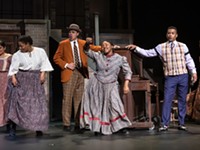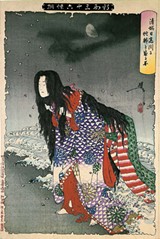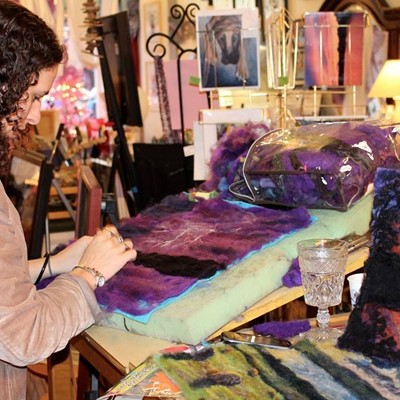"New Ghosts for a New Age: Yoshitoshi's 'New Forms of 36 Ghosts'"
Heroics and horrors
By Rebecca Rafferty @rsrafferty[
{
"name": "500x250 Ad",
"insertPoint": "5",
"component": "15667920",
"parentWrapperClass": "",
"requiredCountToDisplay": "1"
}
]
When the long-isolated Japanese society was opened to the West in 1868, fundamental shifts in the social structure, politics, military, and economy transpired. Master woodcut artist Tsukioka Yoshitoshi was an eyewitness to the conflict and change, and while many artists of his day reflected these shifts, Yoshitoshi spent his final years immortalizing Japan's history and stories. The Memorial Art Gallery recently opened "New Ghosts for a New Age: Yoshitoshi's 'New Forms of 36 Ghosts,'" featuring color woodblock prints from the Arthur R. Miller collection. If you're over the tried-and-true haunts this Halloween, this show provides plenty of eerie, old, new-to-you lore to keep the imagination stoked.
MAG Curator of European Art Nancy Norwood has paired each masterful, intricate print — depicting ghosts, demons, and monsters drawn from ancient legends, history, and theater of Japan — with extensive captions that provide insight into the folklore these vignettes are drawn from, and shed light on symbols characteristic of old Japanese culture.
The beautifully-crafted prints depict exciting and moving stories presented in theatrical gestures, interesting perspectives, and atmospheric settings. Classically trained in centuries-old printing techniques, Yoshitoshi packs each scene with bits of visual interest. He urged even more detail from his already meticulous depiction of textiles by embossing intricate patterns into the paper, and with nearly transparent methods of printing to affect the appearance of mist, shadows, and apparitions.
Yoshitoshi's work contains as much metamorphosis as Ovid's poetry does. Almost nothing is what it seems — a beautiful woman is the spying spirit of a cherry tree, determined to learn a set of evil plans; a demon sneaks up on a hero at rest, disguised as an elegant lady — and the truth can only be detected through indirect means.
In the 1889 print, "Omori Hikoshichi Encountering a Demon," the subject carries a beautiful woman out over moon-lit water, where he detects the shape of horns in her reflection. Yoshitoshi has captured the moment before Omori slays the demon: His furious face possesses terrifying resolve as he looks up at her from the revelatory pool.
Just as demons are exposed by their reflections, animals posing as humans are often sold out by their animal-shaped shadows. And here, as in many western tales, animals may take human form to become the companion of a human for a time, as in the 1889 print, "Heron Maiden." In this serene work, which rests in stark contrast with the violent prints surrounding it, downy snow clumps fall and great birds fly in a soft gray atmosphere around the maiden's elegantly posed figure.
Other works offer simple brushes with the supernatural: Foxfire guides a star-crossed lover to safety as she works to preserve the life of her beloved; and military heros debate with mountain spirits. Downright strange encounters with the wilder elements include a monstrous, mother-devouring carp, and in the 1891 print, "Ranmaru and the Mysterious Sago Palm," we see what would happen if a nature not at our mercy became fed up with our abuses. Ranmaru is lucky the locomotive plant is only running away.
In the 1892 work, "Minamoto no Yorimitsu Striking at the Ground Spider," the beast is almost comically disturbing in its anthropomorphized appearance, but is terrifying nonetheless. Claws and rows of curving, sharp teeth threaten, a subtle web behind it frames a face dominated by bulging, yellow eyes, and the spider holds a gossamer sheet over our hero, who is about to draw his blade.
Oddly enough, the ghost stories are the least strange, but can be startling or full of sorrow. A travelling poet-priest, squatting in a melancholy, abandoned house, offends two insubstantial poet-shades by offering a verse for the work they are discussing. When ghosts are depicted as more than dense shadows, they have no feet — they appear to us but do not dwell here.
In addition to transformation, revenge is a frequent secondary theme. The 1890 work, "Kiyohime Changing into a Serpent at Hidaka River," depicts the result of unrequited love. The scorned woman is shown stepping onto the shore, with dripping tresses and a hunched, elongating back.
Some images deal with premonitions and visions of horror. In the 1890 work, "The Autumn Wind Blows..." an exiled poet-prince calmly casts his lost gaze out a window, where he imagines that he sees the skull of his beloved amid a wasted garden.
Created the same year, "Kiyomori Sees Hundreds of Skulls at Fukuhara" depicts a man disturbed from rest, sitting upright with his hand on his hilt. Tortured by reverie of his own ruthlessness, the immoral Kiyomori stares out the window at not hundreds, but one large skull, which confronts him with wide, hugely dilated eyes, as if seeing all of his sins. The skull, actually comprised of snow-covered rocks and bushes, and the two dark handles of his screen door, is a product of a heavy conscience's hallucination.
The 1892 image, "The Yotsuya Ghost Story" contains no premonition, but a signal to the audience of what's to come. Instead of illustrating the terrors from this well-known kabuki play, Yoshitoshi emphasizes the beauty and love of the doomed character as she nurses her son in peace. But a subtle serpent-shaped sash slithers up to her, hinting at impending horror.
I snorted at the 1890 "Tametomo's Ferocity Drives Away the Smallpox Demons," in which disease is personified as fiends which look like infected people. Amid all of this fantasy, the downright implausibility of threatening an illness with a bow and arrow was the only image that got me to scoff. Apparently I'm down with fox maidens mothering human babies, and grateful badgers turning themselves into discontented teapots. But disease caused by demons? Get out.
Speaking of...
-

“Ragtime” evokes history through rhythm and rhyme
May 8, 2023 -

‘A Change Is Coming’ to RoCo
Feb 3, 2022 -

Film review: 'Ralph Breaks the Internet'
Nov 27, 2018 - More »
Latest in Art
More by Rebecca Rafferty
-

Beyond folklore
Apr 4, 2024 -

Partnership perks: Public Provisions @ Flour City Bread
Feb 24, 2024 -

Raison d’Art
Feb 19, 2024 - More »






